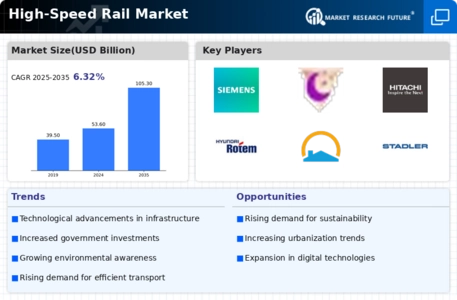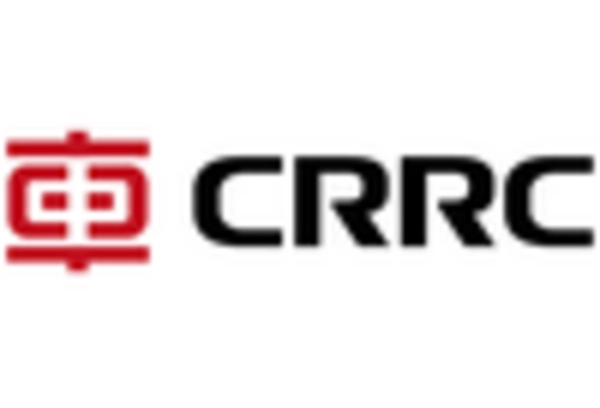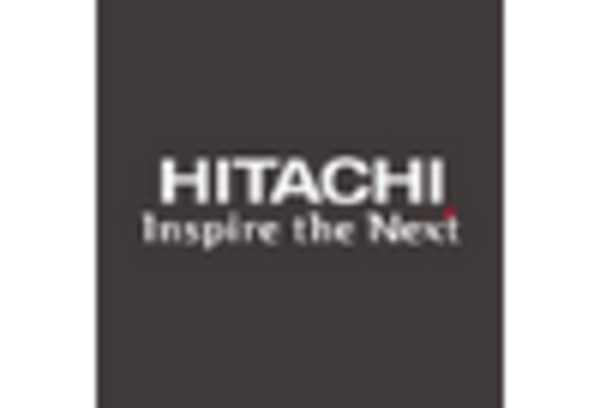Increasing Urbanization
The trend of increasing urbanization appears to be a pivotal driver for the High-Speed Rail Market. As populations in urban areas continue to swell, the demand for efficient transportation solutions intensifies. High-speed rail systems offer a viable alternative to congested roadways and overburdened airports, providing rapid transit options that can accommodate the growing number of commuters. In many regions, urban centers are expanding, leading to a projected increase in high-speed rail ridership. For instance, it is estimated that by 2025, ridership could reach over 500 million passengers annually in certain markets, underscoring the necessity for robust rail infrastructure. This urbanization trend not only enhances the appeal of high-speed rail but also encourages investments in new rail projects, thereby propelling the industry forward.
Technological Advancements
Technological advancements play a significant role in shaping the High-Speed Rail Market. Innovations in rail technology, such as improved train designs, advanced signaling systems, and enhanced safety features, are making high-speed rail more efficient and reliable. For instance, the introduction of magnetic levitation (maglev) technology has the potential to increase speeds beyond traditional high-speed rail capabilities, offering travel times that could rival air travel. Additionally, the integration of smart technologies, such as real-time tracking and automated ticketing systems, enhances the passenger experience and operational efficiency. As these technologies continue to evolve, they are likely to attract more investment and interest in high-speed rail projects, thereby fostering industry growth. The ongoing research and development in this sector suggest a promising future for high-speed rail systems.
Government Investments and Policies
Government investments and supportive policies are crucial drivers for the High-Speed Rail Market. Many governments recognize the potential of high-speed rail to stimulate economic growth, reduce traffic congestion, and lower carbon emissions. As a result, substantial funding is being allocated to develop and expand high-speed rail networks. For example, recent data indicates that several countries have committed billions of dollars to enhance their rail infrastructure, with some nations planning to double their high-speed rail lines by 2030. These investments not only facilitate the construction of new lines but also improve existing services, making high-speed rail a more attractive option for travelers. Furthermore, favorable policies, such as subsidies and tax incentives for rail projects, further bolster the industry's growth prospects.
Rising Fuel Prices and Economic Factors
Rising fuel prices and various economic factors are emerging as significant drivers for the High-Speed Rail Market. As fuel costs continue to fluctuate, consumers and businesses alike are seeking more cost-effective transportation alternatives. High-speed rail offers a competitive solution, often providing lower travel costs compared to air travel, especially for medium-distance journeys. Recent analyses indicate that high-speed rail can reduce travel expenses by up to 30% compared to flying, making it an attractive option for budget-conscious travelers. Additionally, economic growth in various regions is leading to increased disposable income, which may further boost demand for high-speed rail services. As economic conditions improve, investments in rail infrastructure are likely to rise, supporting the expansion of high-speed rail networks and enhancing their viability as a preferred mode of transport.
Environmental Concerns and Sustainability
Environmental concerns and a growing emphasis on sustainability are increasingly influencing the High-Speed Rail Market. As awareness of climate change and pollution rises, there is a marked shift towards greener transportation alternatives. High-speed rail systems are often viewed as a more sustainable option compared to traditional modes of transport, such as automobiles and airplanes, due to their lower carbon footprint. Recent studies suggest that high-speed trains can reduce greenhouse gas emissions by up to 75% compared to air travel. This shift towards sustainability is prompting governments and private investors to prioritize high-speed rail projects, as they align with global efforts to reduce environmental impact. Consequently, the industry's focus on eco-friendly solutions is likely to attract more passengers and investment, further driving growth.


















Leave a Comment